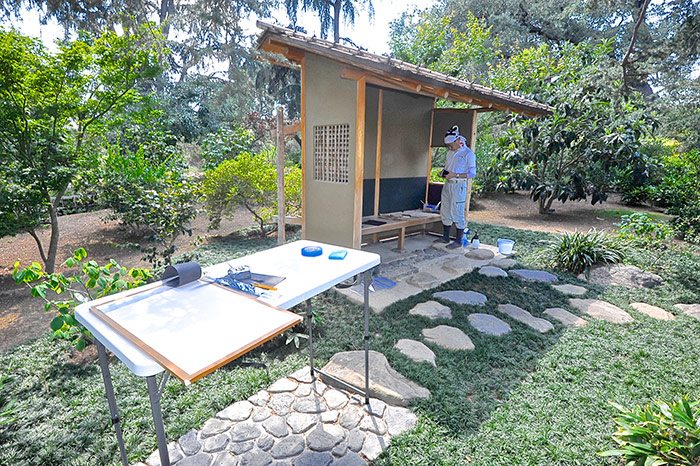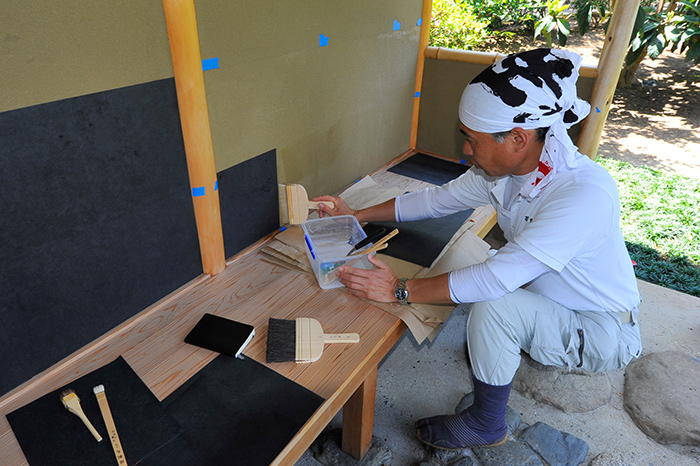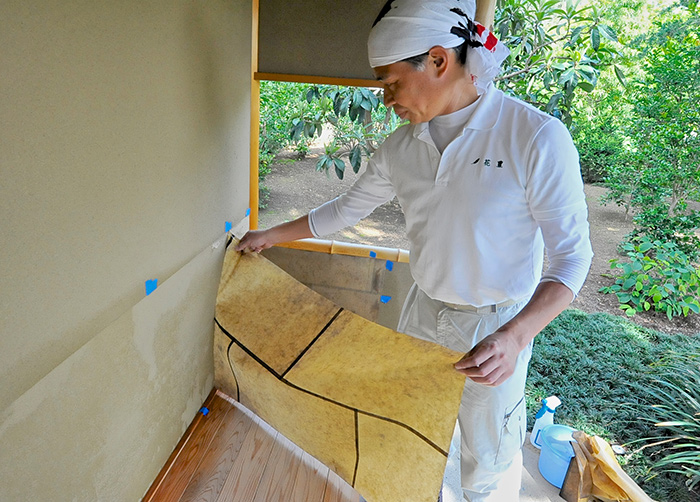The Huntington’s blog takes you behind the scenes for a scholarly view of the collections.
Worth the Wait
Posted on Fri., Aug. 7, 2015 by

As part of periodic maintenance, the tea garden’s machiai or waiting bench received new rice paper to line its walls. Kyoto landscape designer Takuhiro Yamada consults his notes. Photo by Andrew Mitchell.
If you’re thinking of stopping by the Japanese Garden’s Seifu-an teahouse for the second-Monday-of-the-month tour on Aug. 10, then be sure to visit the waiting bench, or Koshikake-machiai, in the tea garden. It recently received a sprucing up by Kyoto landscape architect Takuhiro Yamada, who helped design the tea garden.
In a traditional Japanese tea garden, visitors need a place to wait for the start of the tea ceremony. The Koshikake-machiai (or just machiai) is a sheltered bench where guests sit and contemplate the beauty and tranquility of the garden. The tea ceremony is then signaled by a gong—or, more subtly, by the sound of the host pouring a pail of fresh water into the tsukubai, a basin that tea ceremony guests use to wash their hands and mouth in a symbolic cleansing.
The machiai is exposed to the elements and so requires periodic maintenance. Built from Alaskan yellow cedar (a wood that resembles the prized hinoki, or Japanese cypress), the inside of the structure is lined with a strong Japanese rice paper dyed indigo. The paper helps ensure a guest doesn’t tear or soil her kimono—a garment typically made from hand-dyed silk, which can cost thousands of dollars.
Yamada removed the faded rice paper lining the walls and cut new paper to size. He then used a Japanese raccoon bristle brush to apply a type of glue made from seaweed that has strong fixative properties but is also removable.
Elsewhere in the garden, he added a stone pathway, pruned and shaped some of the shrubs and trees, and put finishing touches on the garden’s second tsukubai.

The landscape designer takes careful measurements and then cuts new pieces. Photo by Andrew Mitchell.
The Huntington installed the tea garden, along with the Seifu-an teahouse, in 2012 to commemorate the Japanese Garden’s 100th anniversary. Kyoto-based architect and craftsman Yoshiaki Nakamura built the machiai. The garden’s design was a collaboration between Yamada and landscape designers Takeo and Keiji Uesugi of Los Angeles.
Three years after the garden’s installation, Yamada is pleased with the results. “This is a good Japanese tea garden,” he says.
Still, he’s waiting for the shrubs and trees to grow larger so that he can further shape them in keeping with traditional Japanese garden aesthetics. Like the guests waiting for the beginning of the tea ceremony, he’s anticipating that it will be worth the wait.

Each panel is glued into place using a strong but removable adhesive made from seaweed. Photo by Andrew Mitchell.
Learn the traditions behind the Japanese Garden’s ceremonial teahouse. Informal tours take place at 20-minute intervals on the second Monday of every month; the next tour occurs on Aug. 10. No reservations required. General admission.
Diana W. Thompson is senior writer for the office of communications and marketing at The Huntington.
